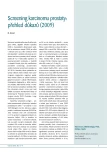DIAGNOSIS OF PROSTATE CANCER AND PCA3
Authors:
J. A. Schalken
Authors‘ workplace:
Department of Urology, University Hospital Nijmegen, Geert, The Netherlands
Published in:
Urol List 2010; 8(1): 15-21
Overview
Although PSA screening plays a key role in increased prostate cancer detection, PSA, as a diagnostic and prognostic marker, is not specific for prostate cancer. Investigators are thus trying to identify markers, which would be specific for prostate cancer and would improve the accuracy of prostate cancer detection. Significant over-expression of PCA3 found in prostate tumors indicates its potential as a diagnostic biomarker. The author of this article is presenting a comprehensive overview of the role of PCA3 in prostate cancer detection and prediction and its use as a valuable tool in clinical practice.
Key words:
PCA3, biomarker, prostate cancer detection
Sources
1. Jemal A, Siegel R, Ward E et al. Cancer statistics, 2008. CA Cancer J Clin 2008; 58(2): 71–96.
2. Ferlay J, Autier P, Boniol M et al. Estimates of the cancer incidence and mortality in Europe in 2006. Ann Oncol 2007; 18(3): 581–592.
3. Roddam AW, Duffy MJ, Hamdy FC et al. Use of prostate-specific antigen (PSA) isoforms for the detection of prostate cancer in men with a PSA level of 2–10 ng/ml: systematic review and meta-analysis. Eur Urol 2005; 48(3): 386–399.
4. Hessels D, Verhaegh GW, Schalken JA et al. Applicability of biomarkers in the early diagnosis of prostate cancer. Expert Rev Mol Diagn 2004; 4(4): 513–526.
5. Hessels D, Rittenhouse H, Schalken J et al. Molecular diagnostics in prostate cancer. EAU Update Series 2005; 6(3): 200–213.
6. Bussemakers MJ, van Bokhoven A, Verhaegh GW et al. DD3: a new prostate-specific gene, highly overexpressed in prostate cancer. Cancer Res 1999; 59(23): 5975–5979.
7. de Kok JB, Verhaegh GW, Roelofs RW et al. DD3 (PCA3), a very sensitive and specific marker to detect prostate tumors. Cancer Res 2002; 62(9): 2695– 2698.
8. Hessels D, Klein Gunnewiek JM, van Oort I et al. DD3 (PCA3)-based molecular urine analysis for the diagnosis of prostate cancer. Eur Urol 2003; 44(1): 8–15.
9. Schalken JA, Hessels D, Verhaegh GW. New targets for therapy in prostate cancer: differential display code 3 (DD3 [PCA3]), a highly prostate cancer-specific gene. Urology 2003; 62 (5 Suppl 1): 34–43.
10. Iwakiri J, Granbois K, Wehner N et al. An analysis of urinary prostate specific antigen before and after radical prostatectomy: evidence for secretion of prostate specific antigen by the periurethral glands. J Urol 1993; 149(4): 783–786.
11. Meng FJ, Shan A, Jin L et al. The expression of a variant prostate-specific antigen in human prostate. Cancer Epidemiol Biomarkers Prev 2002; 11(3): 305–309.
12. van Gils MP, Cornel EB, Hessels D et al. Molecular PCA3 diagnostics on prostatic fluid. Prostate 2007; 67(8): 881–887.
13. van Gils MP, Hessels D, van Hooij O et al. The time-resolved fluorescence-based PCA3 test on urinary sediments after digital rectal examination; a Dutch multicenter validation of the diagnostic performance. Clin Cancer Res 2007; 13(3): 939–943.
14. Groskopf J, Aubin SM, Deras IL et al. APTIMA PCA3 molecular urine test: development of a method to aid in the diagnosis of prostate cancer. Clin Chem 2006; 52(6): 1089–1095.
15. Sokoll LJ, Ellis W, Lange P et al. A multicenter evaluation of the PCA3 molecular urine test: pre-analytical effects, analytical performance, and diagnostic accuracy. Clin Chim Acta 2008; 389(1–2): 1–6.
16. Shappell SB, Fulmer J, Arguello D et al. PCA3 urine mRNA testing for prostate carcinoma: patterns of use by community urologists and assay performance in reference laboratory setting. Urology 2009; 73(2): 363–368.
17. Marks LS, Fradet Y, Deras IL et al. PCA3 molecular urine assay for prostate cancer in men undergoing repeat biopsy. Urology 2007; 69(3): 532–535.18. Deras IL, Aubin SM, Blase A et al. PCA3: a molecular urine assay for predicting prostate biopsy outcome. J Urol 2008; 179(4): 1587–1592.
19. Haese A, de la Taille A, van Poppel H et al. Clinical utility of the PCA3 urine assay in European men scheduled for repeat biopsy. Eur Urol 2008; 54(5): 1081–1088.
20. Ankerst DP, Groskopf J, Day JR et al. Predicting prostate cancer risk through incorporation of prostate cancer gene 3. J Urol 2008; 180(4): 1303–1308.
21. Tomlins SA, Rhodes DR, Perner S et al. Recurrent fusion of TMPRSS2 and ETS transcription factor genes in prostate cancer. Science 2005; 310(5748): 644–648.
22. Tomlins SA, Mehra R, Rhodes DR et al. TMPRSS2: ETV4 gene fusions define a third molecular subtype of prostate cancer. Cancer Res 2006; 66(7): 3396–3400.
23. Hessels D, Smit FP, Verhaegh GW et al. Detection of TMPRSS2–ERG fusion transcripts and prostate cancer antigen 3 in urinary sediments may improve diagnosis of prostate cancer. Clin Cancer Res 2007; 13(17): 5103–5108.
24. Laxman B, Morris DS, Yu J et al. A first-generation multiplex biomarker analysis of urine for the early detection of prostate cancer. Cancer Res 2008; 68(3): 645–649.
25. van Gils MP, Hessels D, Hulsbergen-van de Kaa CA et al. Detailed analysis of histopathological para - meters in radical prostatectomy specimens and PCA3 urine test results. Prostate 2008; 68(11): 1215– 1222.
26. Nakanishi H, Groskopf J, Fritsche HA et al. PCA3 molecular urine assay correlates with prostate cancer tumor volume: implication in selecting candidates for active surveillance. J Urol 2008; 179(5): 1804– 1809.
27. Whitman EJ, Groskopf J, Ali J et al. PCA3 score before radical prostatectomy predicts extracapsular extension and tumor volume. J Urol 2008; 180: 1975–1978.
Labels
Paediatric urologist UrologyArticle was published in
Urological Journal

2010 Issue 1
Most read in this issue
- SURGICAL TECHNIQUE FOR LAPAROSCOPIC ADRENALECTOMY
- LAPAROSCOPIC PARTIAL NEPHRECTOMY
- LAPAROSCOPIC RECONSTRUCTION SURGERY OF UPPER URINARY SYSTEM IN CHILDREN – TECHNICAL ASPECTS
- TECHNICAL ASPECTS OF PERFORMING OF TRANSPERITONEAL LAPAROSCOPIC NEPHRECTOMY
